Casablanca Class Line Drawings
Casablanca Class Line Drawings
- ※データは護衛航空母艦カサブランカ級の項を参照
 |
カサブランカ Casablanca(CVE-55)。艦首材(ステム)の吃水線部分に円弧状の張り出しがある。艦首正面、中央のドーナッツ型のホーズホールの左右に小さな穴。ホーズホール両側の穴からパラヴェーン(Paravane、掃海具)を展張する際に用いるチェーンが海面に伸びていて、間隔はかなり狭い艦首の張り出しは2本のチェーンが接触するのを防ぐためのものか?フライト・デッキの前端のランプ(曲線の傾斜が付いている部分)両端に標識灯(ライト)らしきものが装備されていたり、上辺には空気抜きのようなスリットが見える Bow view of USS Casablanca (CVE-55), 15 August 1944, Astoria, Oregon, in camouflage 32/12A. United States National Archives and Records Administration (NARA), Photo No. 80-G-245593. Image courtesy of NavSource. |
 |
カサブランカ(CVE-55)。トランサム・スターンの特徴が良く分かる。艦尾側のフライト・デッキランプにも両端のライトとスリットが見える。砲座が後方に大きく張り出していて、砲の旋回軸は艦尾端のラインとほぼ同じ位置にあるから、揚弾機を併設するのは無理。5インチ砲座ブルワーク(bulwark)の外側中央には上下に2基のライトが設置されており、セティス・ベイ
Thetis Bay(CVE-90)の配置図では名称はステアリング・ライト(Steering Light)、色は上が白、下が青とされている。その右舷側に艦尾旗竿があって、砲座ブルワーク上端と同じあたりの位置にアンカーライト(停泊灯)が付く。更にその下方、艦尾甲板端の艦尾旗竿の前にライトが1基あり、これはウェーキ・ライト(Wake
Light)という Stern view of USS Casablanca (CVE-55), 15 August 1944, Astoria, Oregon, in camouflage 32/12A. United States National Archives and Records Administration (NARA), Photo No. 80-G-245594. Image courtesy of NavSource. |
 |
ミッション・ベイ Mission Bay(CVE-59)。艦首右側のマストはHF/DFマスト。アンテナはアメリカ海軍のDAQ型。大西洋戦域に配備されたCVE(ボーグ級及びカサブランカ級)はHUK任務に従事しなかった艦でもHFDFマストを装備しており、カサーン・ベイ
Kasaan Bay(CVE-69)とツラギ Tulagi(CVE-72)でも確認できる。太平洋戦域のCVEには無かったもの USS Mission Bay operated primarily as an ASW carrier in the Atlantic. She is shown on 10 August 1944, off the East Coast, wearing Measure 32 Design 4A camouflage. Note Hellcats on deck and the large SK air search radar antenna on the mast. Official U.S. Navy Photograph, from the collections of the Naval History and Heritage Command (# NH 106582). Image courtesy of NavSource. |
 |
セント・ロー St. Lo(CVE-63)。右舷艦首から2番目の20mm機関砲座ブルワークにの外側にはデリック・ブームを格納するためのブラケットがある San Diego, April 1944. Camouflaged in Measure 32, Design 15A. National Archives photo # 80-G-47028. Image courtesy of NavSource. |
 |
トリポリ Tripoli(CVE-64)。右舷艦首にHF/DFアンテナ。舷側のギャングウェイに2本の支柱に支えられて立っている USS Tripoli departs Hampton Roads, May 24, 1944 with Composite Squadron 6 (VC-6; 12 Avengers and 9 Wildcats) aboard. She is painted in camouflage Measure 32, Design 4A (although there are deviations from the original Bureau of Ships design drawing). "Note the HF/DF mast for North Atlantic ASW and the flat hangar deck, indicated by the straight line of the outboard sponsons. The prominent hangar-deck sponsons were used primarily for refueling at sea, the CVEs carrying substantial loads of cargo oil for destroyers and escort destroyers." Photo and text in quotes from U.S. Aircraft Carriers: An Illustrated Design History, by Norman Friedman. Image courtesy of NavSource. |
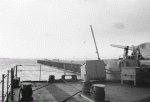 |
トリポリ(CVE-64)。5インチ砲座右舷側。画像左下のアメリカ海軍独特の形状をしたローラー・チョック(Roller Chock、ローラー付きフェアリーダ)に注目。その右舷のやや後方に傾いた箱型の構造物は5インチ砲の装薬を収める即応弾薬ロッカー。更にその右側の少し背の低いロッカーには同じく即応用の5インチ砲弾を格納している(5インチ砲弾は装薬分離式)。1950年代前半、トリポリは大西洋を横断して在欧米空軍とNATO同盟国空軍向けの軍用機の輸送任務に従事 Photos from the collection of Chris Dengler. "Over the next six years [(1952-1958)], Tripoli [, assigned to the Military Sea Transportation Service (MSTS), Atlantic Area,] conducted 44 transport voyages, mostly to European and Mediterranean ports but with one visit to Hawaii and two to the Far East. Following the ship's third voyage to Europe, Tripoli was berthed at the Port Newark Terminal on 5 August 1952 where she loaded 45 Republic F-84 Thunderjet aircraft, 90 wingtip fuel tanks, and related gear for transport to the Far East. After going to sea on 7 August, bound for Japan, Tripoli steamed via the Panama Canal and San Diego and made port at Yokosuka with her vital cargo on 5 September, where cranes lifted the reinforcements ashore-soon to be in action in their ground-attack role in Korea. After onloading battle-damaged aircraft for repairs in the United States, the carrier embarked 245 Navy and Marine Corps personnel for rotation back to Alameda Naval Air Station, Calif. Making port on the west coast on 22 September, she then put to sea for the Far East a second time, once again carrying jet aircraft to Yokosuka, as well as transporting men of the Sea Echelon of Boat Unit 1. Loading a cargo of helicopters and military passengers, Tripoli returned to the west coast and arrived at Alameda on Armistice Day 1952. Subsequently making her sole Hawaiian voyage under MSTS, Tripoli then headed east to finish out her career with transport voyages to European and Mediterranean ports." Quoted from DANFS (Dictionary of American Naval Fighting Ships). Image courtesy of NavSource. |
 |
ウェーク・アイランド Wake Island(CVE-65)。左舷艦首のフライト・デッキにH2-1型油圧カタパルト Overhead port bow view of USS Wake Island (CVE-65) underway in the Hampton Roads, Virginia, area, 9 November 1944. Photographed by N.A.S. Norfolk. National Archives and Records Administration (NARA) photo (# 80-G-289880). Image courtesy of NavSource. |
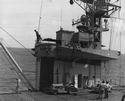 |
キトカン・ベイ Kitkun Bay(CVE-71)。艦橋(アイランド)前面にデリックがあり、航空機や補給物資の積み込みに使用。航行中は水平に倒して舷側に収納しておく。また着艦事故で艦上機が脚を折ってしまったような場合mデリックの旋回半径内であれば機体の移動に使う。アイランドの横に駐車しているのは艦上機の牽引に使用するBN-O-40型トラクター。戦時量産艦らしくアイランドのトップは露天式、最前部の航海/戦闘指揮スペースも三方にウィンドスクリーンがあるだけの質素なものだった。流石に雨風位は防ぎたいというわけで、この時期にはカンヴァスで覆いを追加している。艦橋後方に見える舷側のホイップアンテナは起倒式 04 October 1943: New York Navy Yard, Brooklyn, N.Y. - A yard worker standing in the gun tub of Mount 32 The island of USS Kitkun Bay (CVE-71) during her shakedown cruise in January 1944. The camouflage pattern visible in this port side shot is Measure 32, Design 12A. US Navy photo now in the collections of the National Archives, College Park (# 80-G-373914). Image courtesy of NavSource. |
 |
ガンビア・ベイ Gambier Bay(CVE-73)。手前の巨大なレーダーはSC対空レーダー。サイズは1辺17フィート(5.18m)の正方形で重量1.04t。コンパクトな艦橋に比べて明らかに巨大だが、1943年当時最も高性能の対空レーダーだった。天辺のレーダーはYEアンテナ。艦上機を誘導するための電波(ホーミング・ビーコン Homing Beacon)を発信。形状はレーダーと同じながら用途が異なるので別物に分類。前下方、一つ下のフラットにSG対水上レーダーが見える。SC対空レーダーの後ろ(反対側)はTBS無線アンテナ。YEアンテナの付け根部分に分かりづらいが、信号機のようなものはファイティング・ライト(Fighting Lights)。SGレーダーのすぐ下と、画像下の乗員がいるすぐ下にも1基ずつ装備。SCレーダーの下に24インチ探照灯が2基ある Radar antennae on USS Gambier Bay (CVE-73): YE (top), SG (middle), and SK (bottom). Photographed on 14 January 1944. National Archives and Records Administration (NARA) (# 80-G-218332). Image courtesy of NavSource. |
 |
ネヘンタ・ベイ Nehenta Bay(CVE-74)のイラスト。艦首の突起はパラヴェーン・チェーン用ブラケット。艦載艇は左右両舷に各1隻、舷側のギャングウェイ下面から吊り下げる形で収容。26フィート・モーター救難ボートMk. 2。護衛駆逐艦の艦載艇も同じ型。前下方の張り出し(スポンソン Sponson)にあるウィンチはパラヴェーン揚収用。後方にはボート・ブーム(Boat Boom 係船桁)を格納している。20世紀初頭はヤードと同じくただの円形だったが、さすがに足元が危険なのでこの時代になると上面に平らな足場を設けてある。推進器は2軸。前部エンジンで左舷軸を、後部エンジンで右舷軸を駆動。出力9,000馬力、ボーグ級の8,500馬力と大差ないものの、洗練された船型形状が効果を発揮して最大速力およそ2kt増の20ktとなる。航続距離は19ktで7,200浬、15ktで10,200浬 The Casablanca-class escort carrier Nehenta Bay (CVE-74), January 1944. She was armed with one 5-in/38, eight twin 40-mm, and twenty single 20-mm guns. Drawing and text from U.S. Aircraft Carriers: An Illustrated Design History, by Norman Friedman. Image courtesy of NavSource. |
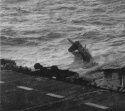 |
ラディヤード・ベイ Rudyerd Bay(CVE-81)。着艦失敗で着水した艦載機。右端に煙突(アップテイク Uptake)が見える。両舷2基、左右同じ位置にある。缶(ボイラー)と主機関(エンジン)を交互に配置、所謂缶・機・缶・機のシフト配置なので前後の間隔があいている。生存性に配慮した設計 From the collection of Mr. Lowell Reistad. USS Rudyerd Bay (CVE-81). Image courtesy of NavSource. |
 |
サギノー・ベイ Saginaw Bay(CVE-82)。フライト・デッキのサイズは144m×24.3m。ボーグ級が133.2m×24.3m。幅は同じだが、全長は10m以上長くなった。船体長はカサブランカ級が156.2m、ボーグ級が151.2mでその差5mだからフライト・デッキの長さを稼ぐべく設計を工夫した USS Saginaw Bay (CVE-82) underway, probably during a ferry mission to Hawaii. U.S. Navy photo, dated April 1944. Image courtesy of NavSource. |
 |
サージャント・ベイ Sargent Bay(CVE-83)。エレヴェーターのサイズは前部が縦12.8m×横10.3m、後部は縦11.55m×横12.8mとわずかに横長の形状になっており、前後2基のエレヴェータ間のスペースが格納庫。格納庫(ハンガー)は長さ77.8m、幅17m、高さ5.32m。40mm連装機関砲は2基ずつ4ヶ所に分けて計8ヶ所装備。砲架2基を1基のMk. 51射撃指揮装置で管制。同じ40mm機関砲なら4連装を装備したいところだが、砲架の重量が連装5t、4連装10tと倍の違いがあったので、トップヘヴィーになるのを避けるため連装で我慢しなければならなかった USS Sargent Bay (CVE-83) . Bow and stern views, 30 May 1944, off the California coast. Painted in Measure 32, Design 15A camouflage. Part of the 40-mm AA battery is under tarpaulins. Image courtesy of NavSource. |
 |
1945年1月03日:メジャー32/22Dを塗装の護衛駆逐艦ロバート F. ケラー Robert F. Keller(DE-419)が、サージェント・ベイに接近し、衝突している。幸いなことに、衝突ののち、それほどひどい状態にはなっていないようだ。ロバート F. ケラーの艦橋の2.5m測距儀が左舷を向いている。接近中に護衛空母との距離を測っていたのか。ギャングウェイ側面に格納された救命イカダが見えているのが上面。下面は舷側を向く形になっている。20mm機関砲ブルワークは機関砲シールド裏側も迷彩色で塗装。床面に1段のリング状ステップが見えるので、砲架は高さの調節ができないMk.
5もしくはMk. 10。暗いが手前の煙突は、右舷前部の煙突。断面は小判型で中央に仕切りがあるだけの簡素な形状。煙路は船体から水平に突き出て90゚上を向いている 03 January 1945: A five view series of USS Robert F. Keller (DE-419), seen wearing camouflage measure 32/22D, making her approach and then colliding with USS Sargent Bay (CVE-83). Image courtesy of NavSource. |
 |
シャムロック・ベイ Shamrock Bay(CVE-84)。多くの空母が前線への航空機の輸送に使用され、シャムロック・ベイも例外ではなかった。1944年7月、太平洋の戦地へ航空機を輸送するシャムロック・ベイの格納庫にある米陸軍航空軍のP-47D。左上のバスケットボールのフープとバックボード、中央の背景の映画スクリーンに注目。国立公文書館写真(# 80-G-335714) Many aircraft carriers were used to ferry aircraft to the front lines and USS Shamrock Bay (CVE-84) was no exception. US Army Air Force P-47Ds in Shamrock Bay's hangar bay in July of 1944 as she delivers them to the war zone in the Pacific. Note the basketball hoop and backboard in the upper left-hand corner and movie screen in the center background. National Archives photo (# 80-G-335714). Image courtesy of NavSource. |
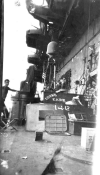 |
シトコー・ベイ Sitkoh Bay(CVE-86)の舷側下。上に見える煙突の下方にアコモデーション・ラダー(Accommodation Ladder
舷梯)が取り付けてある。舷側にある3ヶ所あるスポンソンのうち、中央と後方の2つはおもに洋上での補給作業のためのもの。コンビを組む駆逐艦や護衛駆逐艦は背が低いから、ハイライン作業を考えて高さを近づけている。給油作業で使用するホース(リフュエリング・ホース
Refueling Hoses)を格納。手前は魚雷艇PT-146 Lucky Lady (PT-146) departs from USS Sitkoh Bay (CVE-86). From the collection of LT(JG) Bill Skade. Image courtesy of NavSource. |
 |
シトコー・ベイ(CVE-86)。38口径5インチ両用砲。フライト・デッキ・レヴェルではトップヘヴィーになってしまうので、艦尾の位置になった。射界を出来るだけ広く取るため海面上に大きく張り出して装備されている。砲はMk.
12。砲架はMk. 80。駆逐艦ベンハム Benham(DD-397)以降のバグリー級、シムズ級、ベンソン級は主砲の一部にMk. 30 Mod. 1砲架を装備。航空母艦ヨークタウン級が装備した5インチMk. 21/Mk. 24砲架と同じくシールドの無いオープントップ。ただ、性能は大きく改善されていてMk. 21では揚弾機(ホイスト)が砲から離れた位置にあったのに対してMk.
30では砲架の回転軸と一体の構造となった。給弾が容易になり、発射速度が向上。また信管(フューズ)の設定も揚弾機を上昇する間に自動で行われるので、信管設定装置(フューズ・セッター)とそのための兵員が不要になった。俯仰角-15゚/+85゚、重量17.9t。5インチ両用砲の管制は、水上目標はSGレーダー、航空機はSKレーダーで得た諸元がCIC(戦闘情報センター)経由で砲側に伝えられていた。しかし、どちらのレーダーも精密な射撃指揮ができる程の精度はなかった。1944年10月25日のサマール沖海戦ではガンビア・ベイ(CVE-73)の5インチ砲は当初CICからSGレーダーで得た諸元に基づいて日本艦隊に応戦していた。だが間もなく被弾により通信が途絶してしまい、以後は砲側での直接照準によって射撃を続けた。のちの報告では、砲が使用不能となるまでに2隻の日本海軍重巡洋艦に3発の命中弾を与えたとしている USS Sitkoh Bay (CVE-86). San Francisco to Yokosuka, December 1953. "Also, they did some target practice on way over. Put out a target of barrels with a flag and then circled around somewhere (distance not known) and fired the 5" gun a few times. I (and probably none of the other AF troops) had never been around such a thing. Wow! What a noise! Can't even imagine what a 16"er must sound like. They then continued the circle and picked up what was left of the 'target'." Image courtesy of NavSource. |
 |
シトコー・ベイ(CVE-86)。艦首の右舷側の大きな穴はローラ・チョック(Roller chock)と呼ばれる米海軍独特の形状のフェアリーダ(fair-leader)。ポストが回転することで、係留索が摩擦で痛むのを防ぐ。艦首の先端部分がプレートでカヴァーされていてブルワークと同じ高さ。中央に突き出して見えるのがパラヴェーン揚収用ダヴィッドを差し込むソケット。右下に見える突起が米海軍独特の形状のボラード(bollard)。天辺の張り出しが円形でなく、一辺が少し尖った涙滴型。巻いたロープが上へ抜けないようにとする工夫 "In December 1953 I was one of approximately 250 USAF personnel being transported to Japan. We were all on board the USS Sitkoh Bay, landing at Yokosuka Navy Base, Japan." Image courtesy of NavSource. |
 |
ケープ・エスペランス Cape Esperance(T-CVE-88)。フライト・デッキの前端と後端の左右両舷、計4ヶ所に対空/対水上見張り員席“スカイ・ルックアウト・チェア”(Sky
Lookuot Chair)がある。1ヶ所に3基が標準的な配置 USNS Cape Esperance (T-CVE-88) underway en-route to Korea carrying six Air Force F-84E Thunderjets, two North American F-86 Sabres, eight North American LT-6G Texans, four Lockheed F-80C Shooting Stars, four Navy Grumman F6F-5K Hellcats and five De Havilland Canada L-20 Beaver liaison aircraft. The LT-6Gs were used by the USAF for battlefield surveillance and forward air control duties over Korea. The F6F-5K drones were used by Guided Missile Unit 90 to carry a single 2,000 lb bomb to attack bridges in Korea, flying from USS Boxer (CV-21). They were radio-controlled from an escorting AD Skyraider. Note single 5" gun aft. National Naval Aviation Museum photo (# 1996.488.034.014). Image courtesy of NavSource. |
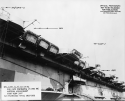 |
ケープ・エスペランス(T-CVE-88)のアンテナ/レーダー群。1954年10月15日のサン・フランシスコ海軍造船所にて。艦載艇の収容状態もわかる USS Cape Esperance (T-CVE-88), antenna arrangement, port view 300゚, San Francisco Naval Shipyard, NY1-1897-(G-S)-10-15-54. 15 October 1954. National Archives and Records Administration (NARA), # rg19nn-b1584-005-001. Image courtesy of NavSource. |
 |
ケープ・エスペランス(T-CVE-88)のアンテナ/レーダー群。1954年10月15日のサン・フランシスコ海軍造船所にて USS Cape Esperance (T-CVE-88), antenna arrangement, port view 315゚, San Francisco Naval Shipyard, NY1-1898-(G-S)-10-15-54. 15 October 1954. National Archives and Records Administration (NARA), # rg19nn-b1584-005-002. Image courtesy of NavSource. |
 |
ケープ・エスペランス(T-CVE-88)のアンテナ/レーダー群。1954年10月15日のサン・フランシスコ海軍造船所にて USS Cape Esperance (T-CVE-88), antenna arrangement, [b]ow view looking aft, San Francisco Naval Shipyard, NY1-1900-(G-S)-10-15-54. 15 October 1954. National Archives and Records Administration (NARA), # rg19nn-b1584-005-003. Image courtesy of NavSource. |
 |
ケープ・エスペランス(T-CVE-88)のアンテナ/レーダー群。1954年10月15日のサン・フランシスコ海軍造船所にて USS Cape Esperance (T-CVE-88), antenna arrangement, stern view looking forward, San Francisco Naval Shipyard, NY1-1902-(G-S)-10-15-54. 15 October 1954. National Archives and Records Administration (NARA), # rg19nn-b1584-005-004. Image courtesy of NavSource. |
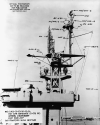 |
ケープ・エスペランス(T-CVE-88)のアンテナ/レーダー群。1954年10月15日のサン・フランシスコ海軍造船所にて USS Cape Esperance (T-CVE-88), antenna arrangement, port view 270゚, San Francisco Naval Shipyard, NY1-1903-(G-S)-10-15-54. 15 October 1954. National Archives and Records Administration (NARA), # rg19nn-b1584-005-005. Image courtesy of NavSource. |
 |
タカニス・ベイ Takanis Bay(CVE-89)。ファイティング・ライト(Fighting Lights)や24インチ探照灯がわかる USS Takanis Bay (CVE-89). Puget Sound Naval Shipyard, May 23, 1946. Topside view of island structure at time of inclining experiment. Puget Sound Naval Shipyard photo #882-46. Image courtesy of NavSource. |
 |
ウィンダム・ベイ Windham Bay(T-CVE-92)のアンテナ/レーダー群。1953年6月3日のピュージェット・サウンド海軍造船所にて "NY8-8370, Puget Sound Naval Shipyard, 3 June 1953, USS Windham Bay (T-CVE-92), Radio/Radar Antenna Arrangement & Rigging, Port View (225゚), (Per BuShips' Manual Chapter 67-44), BS143797" National Archives and Records Administration (NARA), # rg19nn-b1584-005-007. Image courtesy of NavSource. |
 |
ウィンダム・ベイ(T-CVE-92)のアンテナ/レーダー群。1953年6月3日のピュージェット・サウンド海軍造船所にて "NY8-8371, Puget Sound Naval Shipyard, 3 June 1953, USS Windham Bay (T-CVE-92), Radio/Radar Antenna Arrangement & Rigging, Aft View (190゚), (Per BuShips' Manual Chapter 67-44), BS143798" National Archives and Records Administration (NARA), # rg19nn-b1584-005-008. Image courtesy of NavSource. |
 |
ウィンダム・ベイ(T-CVE-92)のアンテナ/レーダー群。1953年6月3日のピュージェット・サウンド海軍造船所にて "NY8-8372, Puget Sound Naval Shipyard, 3 June 1953, USS Windham Bay (T-CVE-92), Radio/Radar Antenna Arrangement & Rigging, Bow View (350゚), (Per BuShips' Manual Chapter 67-44), BS143799" National Archives and Records Administration (NARA), # rg19nn-b1584-005-009. Image courtesy of NavSource. |
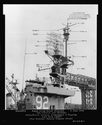 |
ウィンダム・ベイ(T-CVE-92)のアンテナ/レーダー群。1953年6月3日のピュージェット・サウンド海軍造船所にて "NY8-8373, Puget Sound Naval Shipyard, 3 June 1953, USS Windham Bay (T-CVE-92), Radio/Radar Antenna Arrangement & Rigging, Port View (315゚), (Per BuShips' Manual Chapter 67-44), BS143800" National Archives and Records Administration (NARA), # rg19nn-b1584-005-010. Image courtesy of NavSource. |
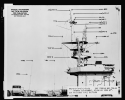 |
ウィンダム・ベイ(T-CVE-92)のアンテナ/レーダー群。1954年1月25日のサン・フランシスコ海軍造船所にて "NY1-253-(G-S)-1-25-54 USS Windham Bay CVE-92, Antenna arrangement, starboard view 90゚. San Francisco Naval Shipyard" 25 January 1954. National Archives and Records Administration (NARA), # rg19nn-b1584-005-011. Image courtesy of NavSource. |
 |
ウィンダム・ベイ(T-CVE-92)のアンテナ/レーダー群。1954年1月25日のサン・フランシスコ海軍造船所にて "NY1-254-(G-S)-1-25-54 USS Windham Bay CVE-92, Antenna arrangement, forward, port view 320゚. San Francisco Naval Shipyard" 25 January 1954. National Archives and Records Administration (NARA), # rg19nn-b1584-005-012. Image courtesy of NavSource. |
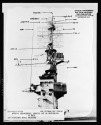 |
ウィンダム・ベイ(T-CVE-92)のアンテナ/レーダー群。1954年1月25日のサン・フランシスコ海軍造船所にて "NY1-255-(G-S)-1-25-54 USS Windham Bay CVE-92, Antenna arrangement, looking aft on centerline of ship. San Francisco Naval Shipyard" 25 January 1954. National Archives and Records Administration (NARA), # rg19nn-b1584-005-013. Image courtesy of NavSource. |
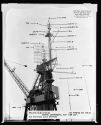 |
ウィンダム・ベイ(T-CVE-92)のアンテナ/レーダー群。1954年1月25日のサン・フランシスコ海軍造船所にて "NY1-256-(G-S)-1-25-54 USS Windham Bay CVE-92, Antenna arrangement, port view 240゚. San Francisco Naval Shipyard" 25 January 1954. National Archives and Records Administration (NARA), # rg19nn-b1584-005-014. Image courtesy of NavSource. |
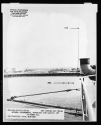 |
ウィンダム・ベイ(T-CVE-92)のアンテナ/レーダー群。1954年1月25日のサン・フランシスコ海軍造船所にて "NY1-258-(G-S)-1-25-54 USS Windham Bay CVE-92, Antenna arrangement, starboard side looking aft at frame 100. San Francisco Naval Shipyard" 25 January 1954. National Archives and Records Administration (NARA), # rg19nn-b1584-005-015. Image courtesy of NavSource. |
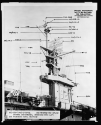 |
ウィンダム・ベイ(T-CVE-92)のアンテナ/レーダー群。1954年1月25日のサン・フランシスコ海軍造船所にて "NY1-260-(G-S)-1-25-54 USS Windham Bay CVE-92, Antenna arrangement, starboard view 120゚. San Francisco Naval Shipyard" 25 January 1954. National Archives and Records Administration (NARA), # rg19nn-b1584-005-016. Image courtesy of NavSource. |
 |
ウィンダム・ベイ(T-CVU-92)のアンテナ/レーダー群 [USNS] Windham Bay (T-CVU 92), antenna arrangement, port view 235゚. Exact date (1955-1958) and location unknown. National Archives and Records Administration (NARA), Identifier: 24741711; Local Identifier: 19-NN-CVL-92 Windham Bay - 152645; Container Identifier: Box 1585, Folder 374. Image courtesy of NavSource. |
 |
ウィンダム・ベイ(T-CVU-92)のアンテナ/レーダー群 [USNS] Windham Bay (T-CVU 92), antenna arrangement, port view 315゚. Exact date (1955-1958) and location unknown. National Archives and Records Administration (NARA), Identifier: 24741713; Local Identifier: 19-NN-CVL-92 Windham Bay - 152646; Container Identifier: Box 1585, Folder 374. Image courtesy of NavSource. |
 |
ウィンダム・ベイ(T-CVU-92)のアンテナ/レーダー群 [USNS] Windham Bay (T-CVU 92), antenna arrangement, looking aft 30゚. Exact date (1955-1958) and location unknown. National Archives and Records Administration (NARA), Identifier: 24741715; Local Identifier: 19-NN-CVL-92 Windham Bay - 152647; Container Identifier: Box 1585, Folder 374. Image courtesy of NavSource. |
 |
ウィンダム・ベイ(T-CVU-92)のアンテナ/レーダー群 [USNS] Windham Bay (T-CVU 92), antenna arrangement, looking aft 30゚. Exact date (1955-1958) and location unknown. National Archives and Records Administration (NARA), Identifier: 24741715; Local Identifier: 19-NN-CVL-92 Windham Bay - 152647; Container Identifier: Box 1585, Folder 374. Image courtesy of NavSource. |
 |
ウィンダム・ベイ(T-CVU-92)のアンテナ/レーダー群 [USNS] Windham Bay (T-CVU 92), antenna arrangement, starboard view 45゚. Exact date (1955-1958) and location unknown. National Archives and Records Administration (NARA), Identifier: 24741719; Local Identifier: 19-NN-CVL-92 Windham Bay - 152649; Container Identifier: Box 1585, Folder 374. Image courtesy of NavSource. |
 |
ウィンダム・ベイ(T-CVU-92)のアンテナ/レーダー群 [USNS] Windham Bay (T-CVU 92), antenna arrangement, starboard view 90゚. Exact date (1955-1958) and location unknown. National Archives and Records Administration (NARA), Identifier: 24741721; Local Identifier: 19-NN-CVL-92 Windham Bay - 152650; Container Identifier: Box 1585, Folder 374. Image courtesy of NavSource. |
 |
ウィンダム・ベイ(T-CVU-92)のアンテナ/レーダー群 [USNS] Windham Bay (T-CVU 92), antenna arrangement, [starboard] view 135゚. Exact date (1955-1958) and location unknown. National Archives and Records Administration (NARA), Identifier: 24741723; Local Identifier: 19-NN-CVL-92 Windham Bay - 152651; Container Identifier: Box 1585, Folder 374. Image courtesy of NavSource. |
 |
ウィンダム・ベイ(T-CVU-92)のアンテナ/レーダー群 [USNS] Windham Bay (T-CVU 92), antenna arrangement, port view 225゚. Exact date (1955-1958) and location unknown. National Archives and Records Administration (NARA), Identifier: 24741725; Local Identifier: 19-NN-CVL-92 Windham Bay - 152652; Container Identifier: Box 1585, Folder 374. Image courtesy of NavSource. |
 |
ウィンダム・ベイ(T-CVU-92)のアンテナ/レーダー群 [USNS] Windham Bay (T-CVU 92), antenna arrangement, looking forward on centerline of ship. Exact date (1955-1958) and location unknown. National Archives and Records Administration (NARA), Identifier: 24741727; Local Identifier: 19-NN-CVL-92 Windham Bay - 152653; Container Identifier: Box 1585, Folder 374. Image courtesy of NavSource. |
Update 25/06/28